August 2024
The global self-driving cars and trucks market volume is calculated at USD 329.21 thousand units in 2025 and is forecasted to reach around USD 8,898.09 thousand units by 2034, accelerating at a CAGR of 44.50% from 2025 to 2034. The North America market volume surpassed USD 110.89 thousand units in 2024 and is expanding at a CAGR of 44.51% during the forecast period. The market sizing and forecasts are revenue-based (USD Million/Billion), with 2024 as the base year.
The global self-driving cars and trucks market volume was calculated at USD 224.21 thousand units in 2024 and is predicted to increase from USD 329.21 thousand units in 2025 to approximately USD 8,898.09 thousand units by 2034, expanding at a CAGR of 44.50% from 2025 to 2034.
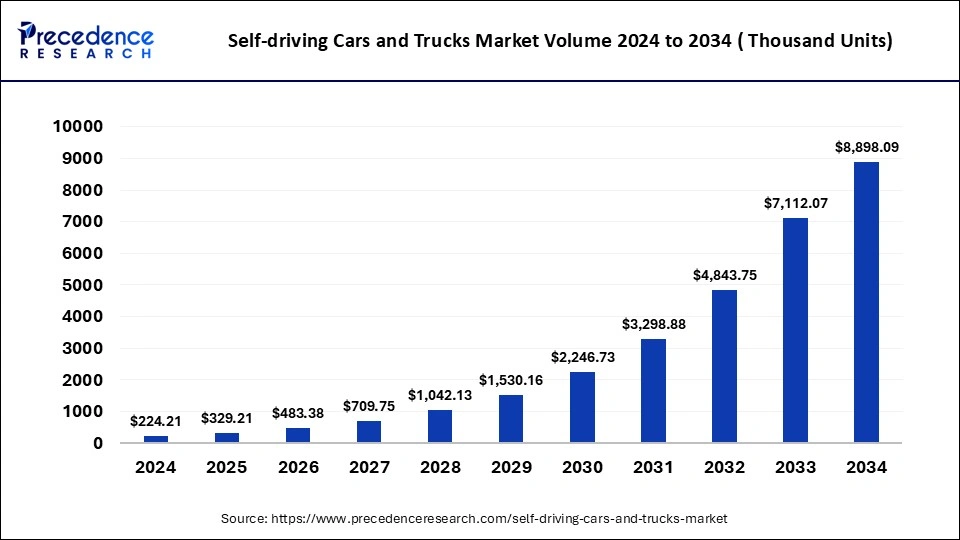
The U.S. self-driving cars and trucks market volume was exhibited at USD 100.89 thousand units in 2024 and is projected to be worth around USD 4,051.55 thousand units by 2034, growing at a CAGR of 44.67% from 2025 to 2034.
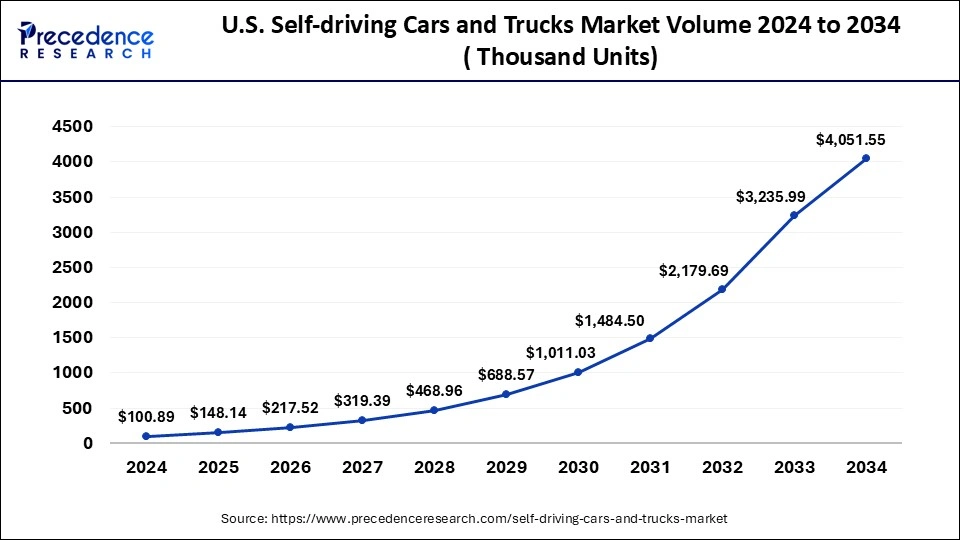
North America held the dominant share of the self-driving cars and trucks market in 2024. The region’s growth is driven by the presence of an established automotive industry coupled with strong research and development capabilities, rising acceptance of self-driving cars and trucks, rigorous emission standards, rising development of high-quality road networks, and a favorable ecosystem for emerging technologies. In addition, rising customer inclination for technology and innovation offers significant growth opportunities for autonomous vehicles. Customers value the safety, convenience, and efficiency offered by self-driving cars and trucks.
Several North American automobile and technology companies are engaged in autonomous vehicle research as well as production. The supportive government regulation makes the testing and deployment of autonomous vehicles on public roads easier. Rising investment in the automobile sector is expected to attract the self-driving cars and trucks market in the region. The robust growth in the delivery business led to a surge in the adoption of self-driving trucks for last-mile deliveries to enhance efficiency and reduce costs. The market has witnessed increasing adoption of self-driving vehicles in the U.S. owing to government amendments to traffic regulations that incorporate autonomous vehicles on public roads. Thus, this is expected to boost the market growth of self-driving cars and trucks in the region during the forecast period.
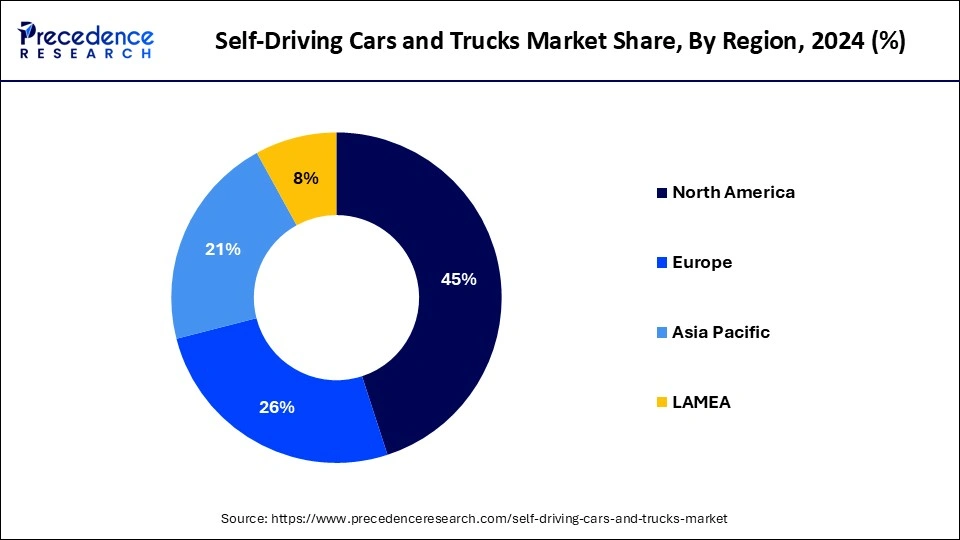
According to the National Safety Council, nonprofit and public service organizations promote health and safety in the United States.
Europe is projected to expand at a rapid pace in the self-driving cars and trucks market during the forecast period owing to the rapid growth of the automotive sector, increasing government initiatives to reduce pollution, rapid urbanization, rising demand for self-driving technology, supportive regulatory framework of government, and rigorous traffic standards. The rising innovation and adoption of self-driving cars and trucks are shaping the future of transportation and mobility in the region. Additionally, partnerships and collaborations among automakers and technology companies to incorporate self-driving technologies are anticipated to boost the growth of self-driving cars and trucks in the region.
Self-driving vehicles are cars, and trucks are driverless vehicles in which the human driver’s role is not involved in taking control and safely operating the vehicle. Self-driving vehicles are also commonly known as autonomous or driverless vehicles. The self-driving cars and trucks market uses cameras, sensors, radar, and artificial intelligence (AI) to travel between locations, and these technologies sense the conditions around them, such as traffic and pedestrians, and avoid road hazards as well as adjust their speed without human intervention. Several companies are engaged in developing and testing autonomous vehicles, such as BMW, Audi, Daimler AG, Ford, Toyota Motor Corporation, Google, Tesla, Volkswagen, Volvo, General Motors, and others.
| Report Coverage | Details |
| Market Volume by 2034 | 8,898.09 Thousand Units |
| Market Volume in 2025 | 329.21 Thousand Units |
| Market Volume in 2024 | 224.21 Thousand Units |
| Market Growth Rate from 2025 to 2034 | CAGR of 44.50% |
| Largest Market | North America |
| Base Year | 2024 |
| Forecast Period | 2025 to 2034 |
| Regions Covered | North America, Europe, Asia-Pacific, Latin America, and Middle East & Africa |
Rising innovation in automotive technology
The rapid innovation in automotive technology is expected to boost the self-driving cars and trucks market during the forecast period. The ongoing evolution of automotive technology is likely to deliver more safety benefits than earlier technologies. Self-driving cars and trucks can handle various tasks without a driver's involvement. Automated safety technologies in vehicles assist in saving lives and preventing injuries on roads.
New braking technologies are designed to warn about the risk of an impending crash and take other preventive actions to avoid a crash. Autonomous vehicles are manufactured with advanced equipment connected to smartphones. Automobile manufacturers are highly investing in improving self-driving capabilities, which include RADAR, LIDAR, GPS, sensors, cameras, and artificial intelligence to travel between locations without a human driver. Such factors positively impact the self-driving cars and trucks market during the forecast period.
High cost
The high cost associated with autonomous vehicles is anticipated to hamper the growth of the self-driving cars and trucks market. The high capital required, which includes the purchasing price and maintenance expenses, often discourages consumers and businesses from purchasing due to budget constraints. In addition, the lack of adequate infrastructure, particularly in low and middle-income countries, such as roads and traffic signals necessary to accommodate autonomous vehicles, may restrict the expansion of the market.
Rising focus on road safety
The rising focus on road safety is expected to boost the acceptance of the self-driving cars and trucks market in the coming years. Autonomous vehicles have the potential to transport goods and help people travel around the world. The AI technology behind autonomous vehicles tends to handle traffic situations. The government's rising restrictions to boost road safety are expected to increase the adoption of self-driving cars and trucks.
Vehicle sensors can detect various road features and obstacles, including curbs, pedestrians, lane markings, bicyclists, and other vehicles. Self-driving automation technologies help improve safety, are well-suited for interstate highways, and are expected to drive the growth of the self-driving cars and trucks market during the forecast period.
The transportation segment accounted for the dominating share of the self-driving cars and trucks market in 2023. The growth of the segment is driven by the rising significant popularity of electric and hybrid vehicles which spur the demand for autonomous vehicles. The adoption of self-driving cars and trucks has the potential to boost transportation effectiveness by streamlining routes, improving road safety, reducing carbon footprints, and easing traffic. The use of autonomous vehicles has favorable effects on the environment and reduces overall fuel consumption.
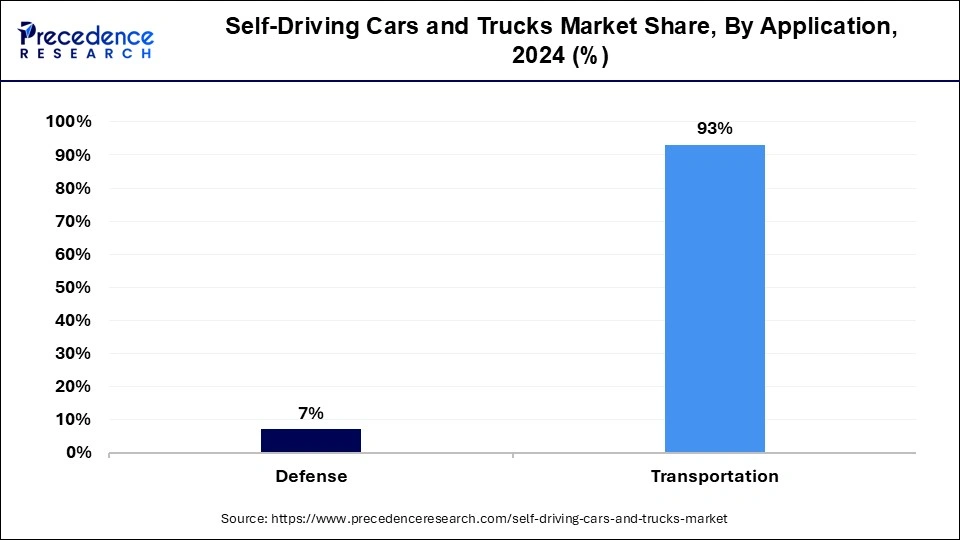
Driverless vehicles can also make decisions to optimize their movements and reduce journey time due to the excellent algorithms and real-time data processing. The stringent government regulation on carbon emission and road safety increases the introduction of self-driving cars and trucks onto public roads. Self-driving technology ensures transportation networks work properly and safely. Autonomous vehicles can run constantly without a break, which attracts businesses to adopt these vehicles. Such factors drive the growth of the self-driving cars and trucks market during the forecast period.
The defense segment is expected to witness significant growth in the self-driving cars and trucks market during the forecast period. This growth can be attributed to the increasing deployment of self-driving vehicles in the defense sector. Several governments in the defense sector are amending transport regulations to create a gateway for driverless cars.
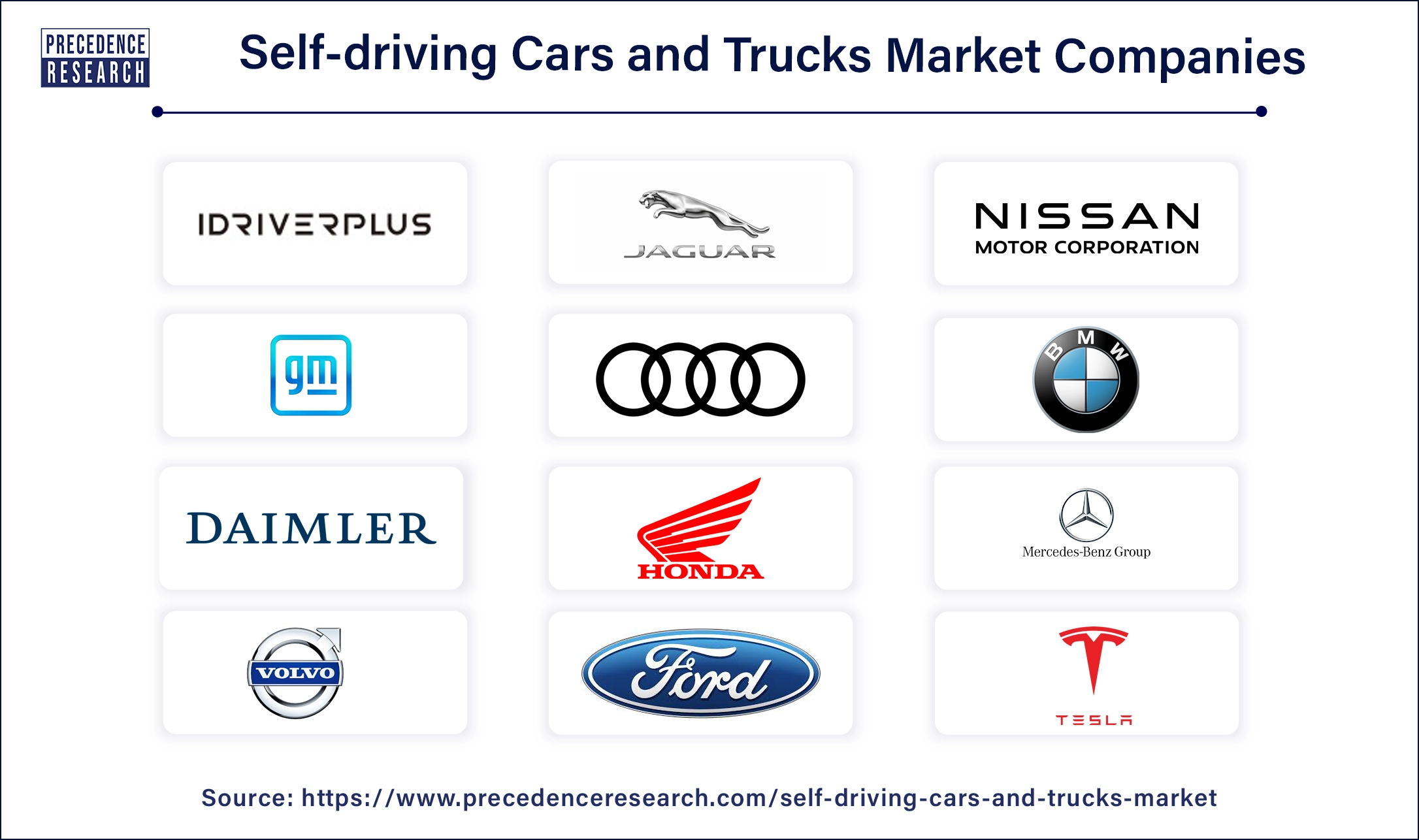
By Application
By Geography
For inquiries regarding discounts, bulk purchases, or customization requests, please contact us at sales@precedenceresearch.com
No cookie-cutter, only authentic analysis – take the 1st step to become a Precedence Research client
August 2024
April 2025
November 2024
August 2024